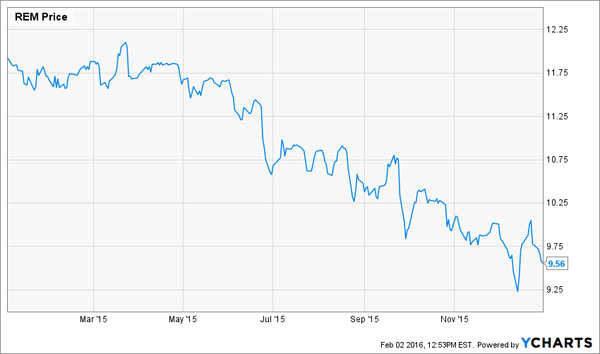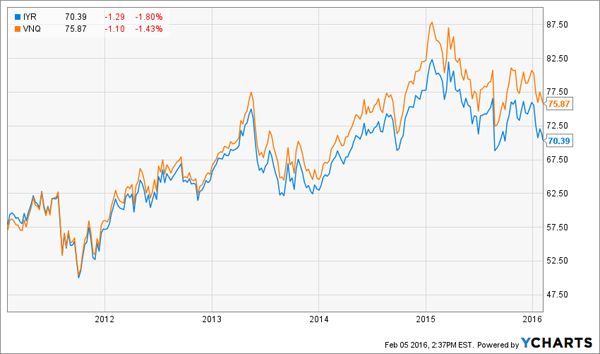Slowly but surely, investors are once again prioritizing dividends.
After suffering a full-on panic attack over the Fed’s interest rate hike last year—and ditching high-yielding investments like real estate investment trusts (REITs) in the process—they’re having a change of heart.
You can see it in the performance of the Vanguard REIT Index Fund (VNQ), an ETF we’ll examine in more detail below: so far in 2016, VNQ has returned 2% versus just 0.5% for the S&P 500.
Call it a late realization that the rate “liftoff” is mostly a non-event for REITs. Because even if the Fed follows through on its plan to raise rates this year (a big “if” in light of the wavering global economy and cowed US inflation), you’ll still be waiting a very long time for safer vehicles like Treasuries to play in the same league as REITs throwing off yields of 6% or more.
History backs that up, and puts paid to the notion that REITs and interest rates head in opposite directions: from October 2004 to June 2006, a period when rates rose from 2.75% to 6.25%, VNQ actually gained 34%.
Now, with the selloff cutting REITs’ prices and upping their dividend yields—VNQ’s 3.8% yield is near a six-year high—it’s a great time to add them to your portfolio.
4 REIT ETFs to Watch
An easy way to get into the sector is through REIT-focused exchange traded funds. Here are four, from the most dangerous to my top buy now.
iShares Mortgage Real Estate Capped ETF (REM) boasts an eye-popping yield of 11.6%, but its portfolio, 99% of which is devoted to mortgage REITs, boasts eye-popping risk to match.
That’s because, as I wrote in November, mortgage REITs are way more sensitive to interest rates than “equity” REITs, or those that own or invest in property.
Mortgage REITs buy or originate mortgages and mortgage-backed securities, which they fund with short-term debt. Their profits come from the spread between the rates they pay out on the money they borrow and the interest income on their mortgages.
That almost sounds like a stable investment, but there’s a big catch: these REITs use a lot of leverage, so a sharp jump in interest rates quickly amps up their borrowing costs. The inevitable result—a chop to the dividend—will have investors pounding the sell button, and sending the REIT’s unit price off a cliff.
2015 Rate Panic Runs Over REM

The fund also devotes a big chunk of its portfolio to one REIT: Annaly Capital Management Inc. (NLY), at 17.3%. Annaly is the biggest mortgage REIT and should be able to hold its payout steady in the near term, as long as rates don’t rise too quickly, but REM’s other holdings don’t inspire my confidence.
My view: if you really must hold mortgage REITs, you’re better off directly investing in Annaly itself, which yields 11.5%, almost the same as the iShares Mortgage Real Estate Capped ETF. You’ll also save yourself the 0.48% MER.
iShares Residential Real Estate Capped ETF (REZ) focuses entirely on the residential real estate sector. The fund has posted a 64% total return since it started trading in May 2007, which is impressive, considering that period included the housing meltdown.
REZ has 47.4% of its portfolio in residential REITs and 12.1% in Public Storage (PSA), the world’s biggest owner of the lockable rooms you stow your extra stuff in. Understated as it is, the business is a cash cow, and PSA has been sharing the wealth with investors, delivering annual dividend hikes to the tune of 22.5% on average over the past five years.
The fund is also heavily focused on healthcare REITs (31.5% of the portfolio), including two big names: Ventas, Inc. (VTR) and Welltower Inc. (HCN), at 7.6% and 6.4% of its holdings, respectively.
The pair’s combined portfolio includes 2,700 healthcare properties, heavily slanted toward seniors’ housing. And with the 85+ population set to triple in the next 30 years, this is a market that’s only just started to boom.
The drawbacks? REZ’s 0.48% MER ties it for the highest among our four ETFs. Meantime, you’ll be pocketing a 3.1% dividend yield, which isn’t much to get excited about compared to the next two ETFs, which pay out far more and give you greater diversification and lower fees, to boot.
If you’re looking for a one-stop shop for exposure to the leading equity REITs, the iShares US Real Estate ETF (IYR) should be on your watch list. The fund holds 119 REITs, with the top 10 representing 36% of its portfolio. It yields 3.8%.
Its biggest holding is Simon Property Group, Inc. (SPG), which has shopping centers across the US, Europe and Asia. Simon yields 3.5%, which is on the low side for a REIT, but it has a gripping dividend-growth story to tell, having doubled its payout in the past five years.
Like REZ, IYR also holds Welltower and Ventas, but at lower doses of 2.8% and 2.2% of the portfolio, respectively.
So why doesn’t IYR take the crown? Two reasons.
First, its 0.43% MER is still on the high side, and investors aren’t getting any more bang for their buck: over the past 10 years, the fund has posted a total return of 50%, far below the next pick I’m going to tell you about. Second, IYR holds 4.8% of its portfolio in riskier mortgage REITs.
For those reasons, I think you’re better off investing in the Vanguard REIT Index Fund (VNQ), which is in some ways a mirror image of the iShares US Real Estate ETF. VNQ is the granddaddy of REIT ETFs and, as I did off the top, is the one scribes often cite as the benchmark for the sector’s performance.
Like IYR, VNQ invests in many REITs—153 in this case—and the top 10 represent a similar proportion (37%) of the portfolio. The two funds also pay similar dividend yields.
There’s a lot of familiarity in their top 10 holdings, too, with Simon Property Group again holding top spot along with Ventas, Welltower, and HCP Inc. (HCP), also making an appearance.
But VNQ has an edge in other areas, like greater exposure to healthcare REITs and a portfolio devoid of mortgage REITs.
VNQ’s Curb Appeal

Best of all, VNQ has a solid history of delivering maximum performance at minimum cost. Not only has it outperformed IYR in the past five years, it’s done so at a bargain basement 0.12% MER—72% less than its rival.
But instead of messing around with REIT ETFs, I prefer to handpick my own stocks. This way, I can lower my risk AND achieve a yield that’s double VNQ’s – literally as high as 8.9%.
I love three REITs focused on the healthcare sector in particular, as they’re benefiting from one of the biggest demographic shifts in history. While the S&P tanks, there’s a massive stealth bull market unfolding as the Baby Boom generation gets older. Consider that:
- There are 77 million Baby Boomers in the U.S. who just started retiring.
- Roughly 10,000 of them will turn 65 every single day for the next 17 years.
- We’re living longer than ever but will require more care as we get older.
- Healthcare spending in the U.S. will increase to $5.43 trillion by 2024.
And unlike the healthcare REITs that these ETFs own, most investors haven’t heard of my favorite firms yet. This means that not only can you collect yields up to 8.9% today, but you’re also positioned to collect 15-20% upside in just the next 12 months as other investors pile into these reliable dividend payers.
That’s why I’m encouraging my subscribers to lock in these juicy dividends today while they’re still cheap. Get the details on all 3 and start profiting right now.
